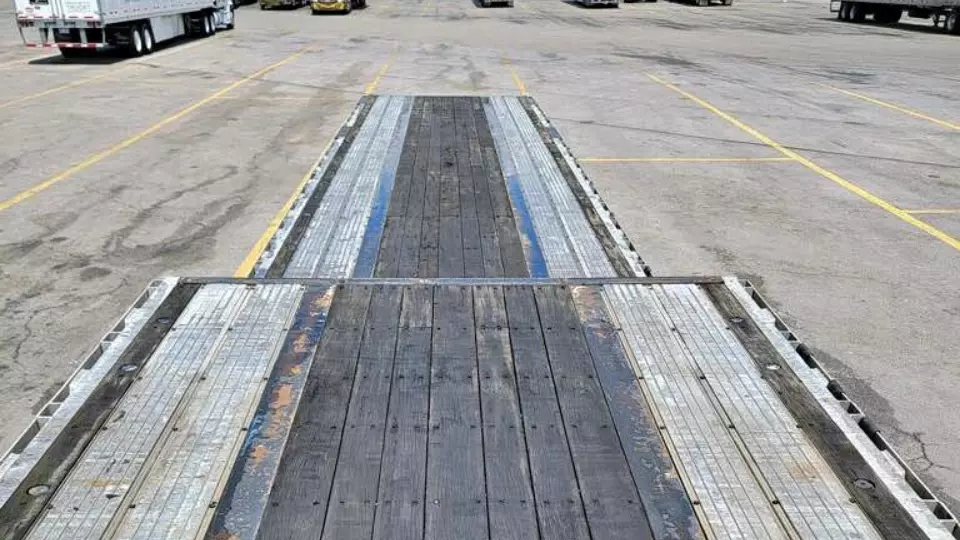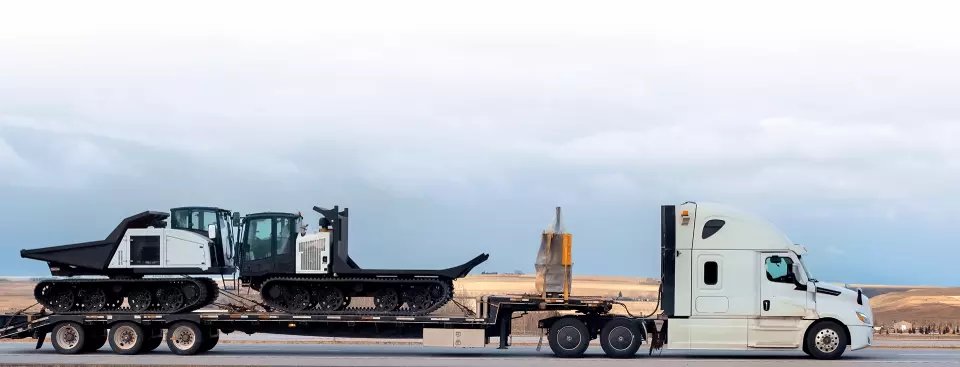The trucking industry requires a variety of equipment to haul different types of cargo, including perishable goods, hazardous materials, retail products, and more. Most semi-trucks hook different types of trailers, such as reefers, flatbed trailers, and tankers, to transport goods.
Step deck trailers are among the most innovative additions to the list of trailer types in the industry. These open trailers are a variation of flatbed trailers and are designed to transport tall and heavy cargo.
In this article, we’ll provide a comprehensive guide on step deck trailers by explaining what they are used for and listing their standard dimensions and capacity. We’ll also share the key advantages and disadvantages of this trailer type and how they compare with other popular trailers in the industry.
What Is a Step Deck Trailer?
A step deck trailer, also known as a drop-deck trailer, is an open trailer with a cargo bed featuring two decks – the lower deck and the upper deck. The key purpose of this design is to allow for the transportation of taller cargo while maintaining legal height restrictions.
By using a step deck trailer, carriers can transport cargo up to 10 ft. in height. The upper deck on the front of the trailer is typically 11 ft. in length and is high enough to couple to a semi-truck’s fifth wheel.

In contrast, the lower deck (at the rear) is usually between 37 – 42 ft. in length and is just a little more than 3ft. from the ground. The lower deck clearance is what provides the additional vertical clearance for transporting taller cargo.
Due to this design, step deck trailers are excellent for transporting oversized cargo on routes with low bridges and overpasses. Step deck trailers also offer more versatility in terms of cargo handling, especially if they have beavertail trays or ramps installed.
Moreover, these trailers are also equipped with various tie-down points that improve security during transit, as the cargo can be securely fastened.
How To Load & Unload Step Deck Trailers
Although step deck trailers have a unique design, the loading and unloading process is relatively straightforward. Below, you’ll find the standard loading and unloading process:
- Inspecting Cargo Before Loading – The first thing that should be done is to ensure that the cargo is properly packaged and prepared according to safety standards and regulations.
- Safely Positioning The Trailer – Next, the truck driver should park the trailer on a leveled surface in a secure area and align it with a ramp or loading dock. Cargo handlers also need to check and ensure there are no obstructions around the trailer and the surroundings so there’s enough space for handling equipment to carry out the loading activities.
- Loading The Trailer – By using a forklift, crane, or other equipment according to the cargo type (palletized goods, vehicles, construction material, etc.), the cargo is loaded onto the trailer. Equipment handlers must use the right loading and positioning techniques for even weight distribution and practice safety precautions.
- Securing The Cargo – Once the cargo is loaded, the next step is to secure it with cables, straps, chains, or other appropriate tie-downs.
- Unloading The Trailer – To unload a step deck trailer, the steps to do so are the same as above but in reverse order. Once the trailer is parked at the unloading facility, all tie-downs need to be removed. Lastly, the cargo handlers unload the cargo from the trailer.
Step Deck Trailer Dimensions & Capacity
Step deck trailers are available in different dimensions and limitations, having a maximum length between 48 and 53 ft. Like most conventional trailers, they’re around 8.5 ft. wide. The upper deck is about 5 ft. from the ground, whereas the lower deck has a ground clearance of about 3 – 3.5 ft.
With this additional vertical clearance, truckers can haul freight with a maximum height of 10 ft. As far as the weight capacity goes, step deck trailers can haul between 43,000 and 48,000 lbs, depending on their length and axle configuration.
Like most open trailers, it has no sides, roof, or doors so it can carry oversized and tall cargo with dimensions exceeding the trailer base width, including large machinery and equipment.
Step Deck Trailer Costs
Step deck trailers vary in terms of cost depending on their make and model, condition, capacity, length, and features. Used trailers and older models typically cost between $10,000 and $40,000, while brand-new step deck trailers can cost anywhere between $50,000 and $90,000
Before you invest in a step deck trailer, especially an older model, it’s important to make sure that you inspect its decks and body thoroughly for damages or signs of wear. Pay special attention to the tires for cracks, excessive wear, and tear near the frame, as well as patches, and bulges.
Also, ensure to check the rims for cracks or missing nuts and the brakes for air leaks. Finally, check the suspension and fifth wheel to assess the trailer’s actual condition before making your investment.
If your business requires an irregular use of a step deck trailer, you may also opt for leasing options which typically fall within a price range of $700 to $900. Doing so can be more economical, as it helps to avoid underutilizing your trailers. Moreover, depending on your needs, it will allow you to choose from different models and configurations.
Types of Cargo Hauled by Step Deck Trailers
As mentioned earlier, step deck trailers can be used to transport various types of oversized, heavy, and tall cargo. Below, you’ll find a more comprehensive list.

Heavy Machinery
Step deck trailers are excellent for heavy machinery, such as bulldozers, tractors, excavators, and harvesters. These trailers are lower than most standard trailers and can be equipped with ramps to accelerate and simplify loading and unloading.
Heavy-Duty Vehicles
While car carriers generally transport cars and smaller vehicles, step deck trailers are designed to transport heavy-duty vehicles such as box trucks, semi-tractors, and similar.
Construction Materials
Large construction materials, such as steel beams, pipes, lumber, and concrete forms, can occasionally exceed the legal height limit when transported in large quantities. Step deck trailers can provide more vertical space to maximize the trailer’s weight capacity.
Industrial Equipment
Industrial equipment, including generators, compressors, boilers, transformers, and tanks, among many others, can easily exceed legal height limits. Hence, step deck trailers provide additional vertical clearance to enable their transport on routes with tunnels and overpasses.
Modular Units
Like intermodal chassis or skeletal trailers, step deck trailers can also carry shipping containers and can serve as a viable alternative when standard trailers aren’t available. Moreover, they’re excellent for transporting prefabricated structures with large dimensions, including mobile and modular homes.
Oversized Cargo
Finally, step deck trailers are the go-to choice for transporting oversized cargo, such as large crates, specialized equipment parts, cranes, and manufacturing columns.
Advantages of Step Deck Trailers
Below are some of the key reasons step deck trailers have become one of the most used trailer types in the industry:
- Height Allowance – The key benefit of using a step deck trailer is the additional vertical clearance. Their lower deck allows them to legally haul tall cargo up to 10 ft. without having to apply for special permits.
- Load Flexibility – Step deck trailers are exceptionally versatile. They can haul most cargo types typically hauled by dry van trailers and even transport intermodal containers with ease.
- Ease of Cargo Handling – Due to their lower ground clearance, step deck trailers provide better access to forklifts. Plus, if the trailer has ramps or a beavertail, handlers can roll cargo up and down during handling. This comes in handy when hauling vehicles and heavy machinery like tractors and excavators.
- Better Stability – The rear deck of a step deck trailer lowers its overall center of gravity, making it one of the safest trailer types in the industry and less likely to be involved in a rollover or jackknife accident.
Disadvantages of Step Deck Trailers
Like all trailer types, this type of trailer comes with a few disadvantages, which we will explore in this section.
- Exposure of Cargo – As explained earlier, step deck trailers are open trailers with no roof, walls, or doors. Therefore, the cargo they transport is more susceptible to damage from debris, rain, extreme temperatures, and adverse weather conditions. Therefore, any sensitive cargo transported using these trailers should be protected by covers or crates.
- Limited Deck Space – The upper deck in a step deck trailer can take up valuable space that can affect how much cargo you transport in a single trip. The space becomes even more limited if you install a ramp or beavertail.
- Requires Driver Competency – Not every driver can operate a truck safely or accurately when hauling a step deck trailer. These trailers often carry oversized cargo, so drivers need to balance weight distribution and plan routes according to the total cargo height. Moreover, they should know how to properly secure cargo with the right tie-downs.
- Higher Initial Cost – Due to their versatility and unique design, step deck trailers are generally more expensive than standard flatbed trailers, depending on the model, capacity, and condition.
Step Deck Trailer Comparisons
Below, we’ll compare step deck trailers with other comparable trailer types in the industry and explain their similarities and differences:
Step Deck Trailer Versus Flatbed Trailer
Step deck trailers are essentially a type of flatbed trailer since it’s an open deck equipment or cargo bed with no sides or roof. Both of these trailers can haul cargo of different shapes and sizes.
Moreover, they allow handlers to secure cargo with tie-down points. Furthermore, they transport almost the same types of cargo with a few exceptions. However, these trailers have different designs. As the name suggests, flatbed trailers have a flat cargo bed.
In contrast, step deck trailers have an upper and lower deck that increases the maximum cargo height but may reduce the overall length when hauling loads. Simply put, flatbeds are better for longer cargo, whereas step deck trailers are ideal for taller cargo.
As far as price is concerned, step deck trailers are slightly more expensive because they allow shippers to move cargo up to 10 ft. in height without obtaining special permits. Moreover, their design enables faster and more convenient loading and unloading.
Step Deck Trailer Versus Double Drop Trailer
Double drop trailers, also known as lowboy trailers, are used for the same purpose as step deck trailers. However, they feature a lower ground clearance than step deck and flatbed trailers. Moreover, instead of two deck levels, they feature three – front, rear, and middle well (lower deck).
The lower deck or section is excellent for transporting extremely heavy equipment, machinery, and industrial components. This section provides better stability and a higher vertical clearance of up to 11.5 ft.
However, due to an additional section, the lower deck of a double drop trailer is typically shorter in length compared to step deck trailers. This also reduces the total transport volume, even though it can increase the weight capacity to 80,000 lbs depending on the number of axles.

Get Free Course Access
If you enjoyed the article, don’t miss out on our free supply chain courses that help you stay ahead in your industry.

Andrew Lin
Co-Founder & Writer
at freightcourse
About the Author
Andrew is a multi-business owner with over 12 years of experience in the fields of logistics, trucking, manufacturing, operations, training, and education.
Being the co-founder of freightcourse has given him the ability to pursue his desire to educate others on manufacturing and supply chain topics.
Follow us